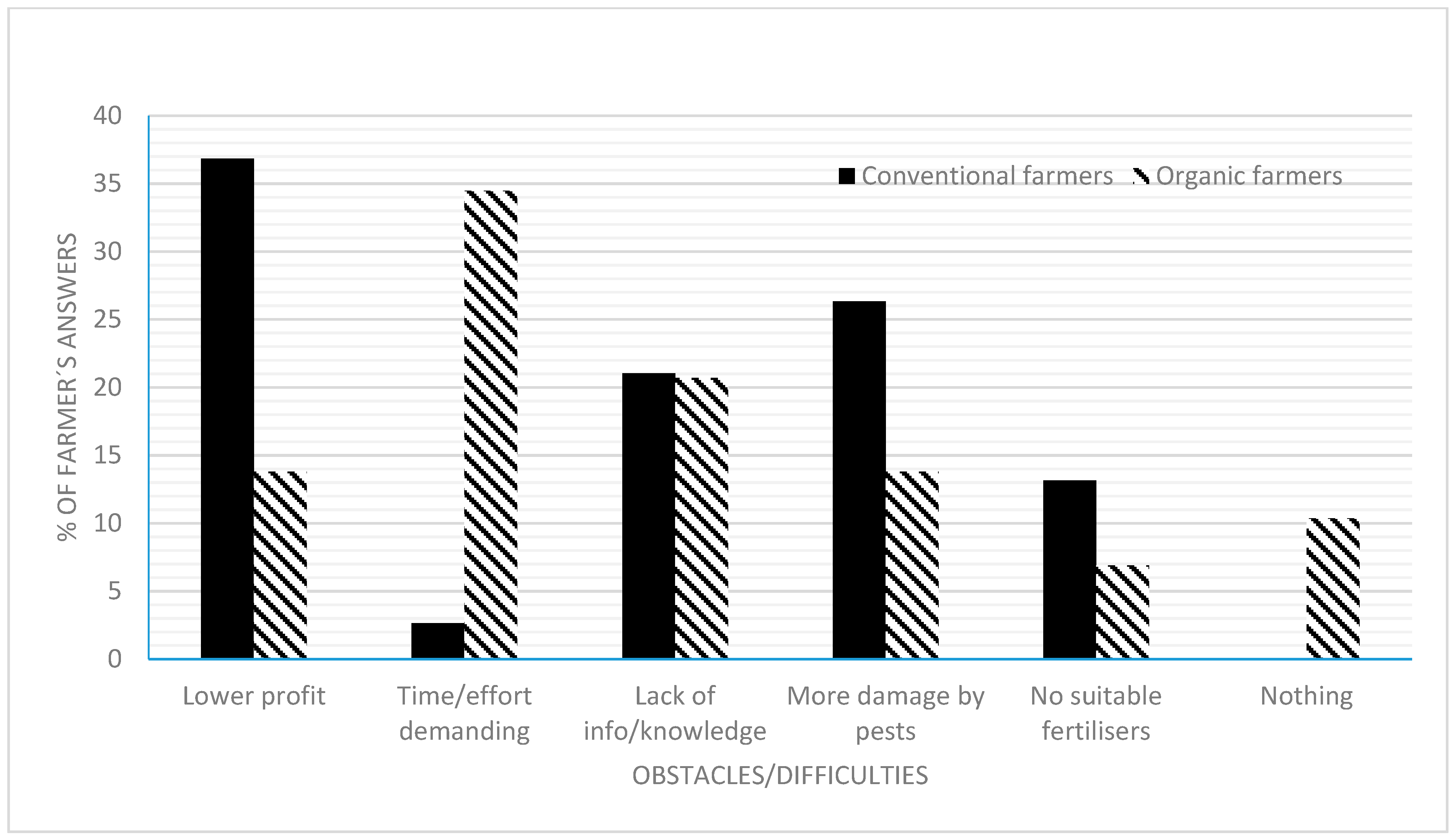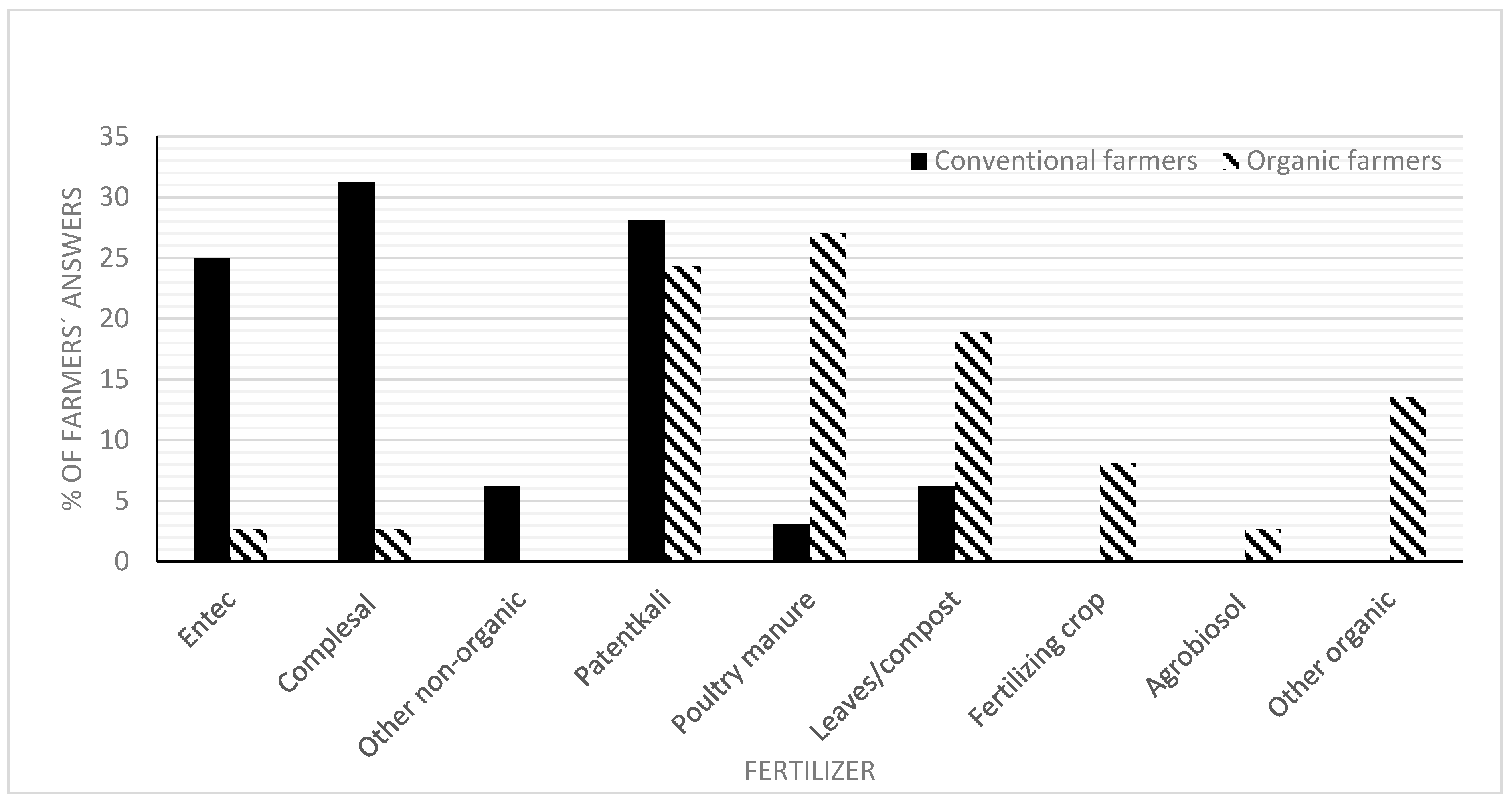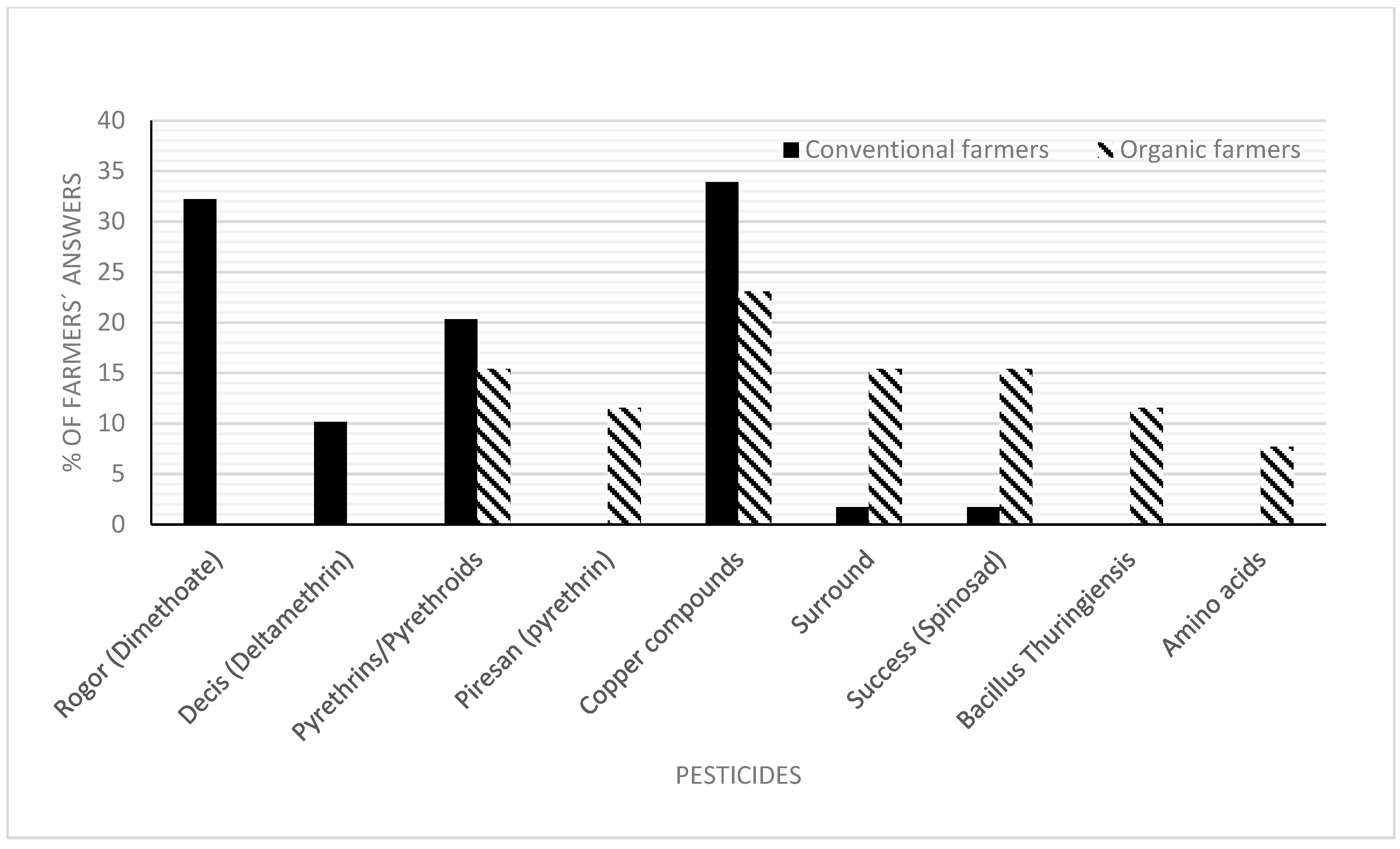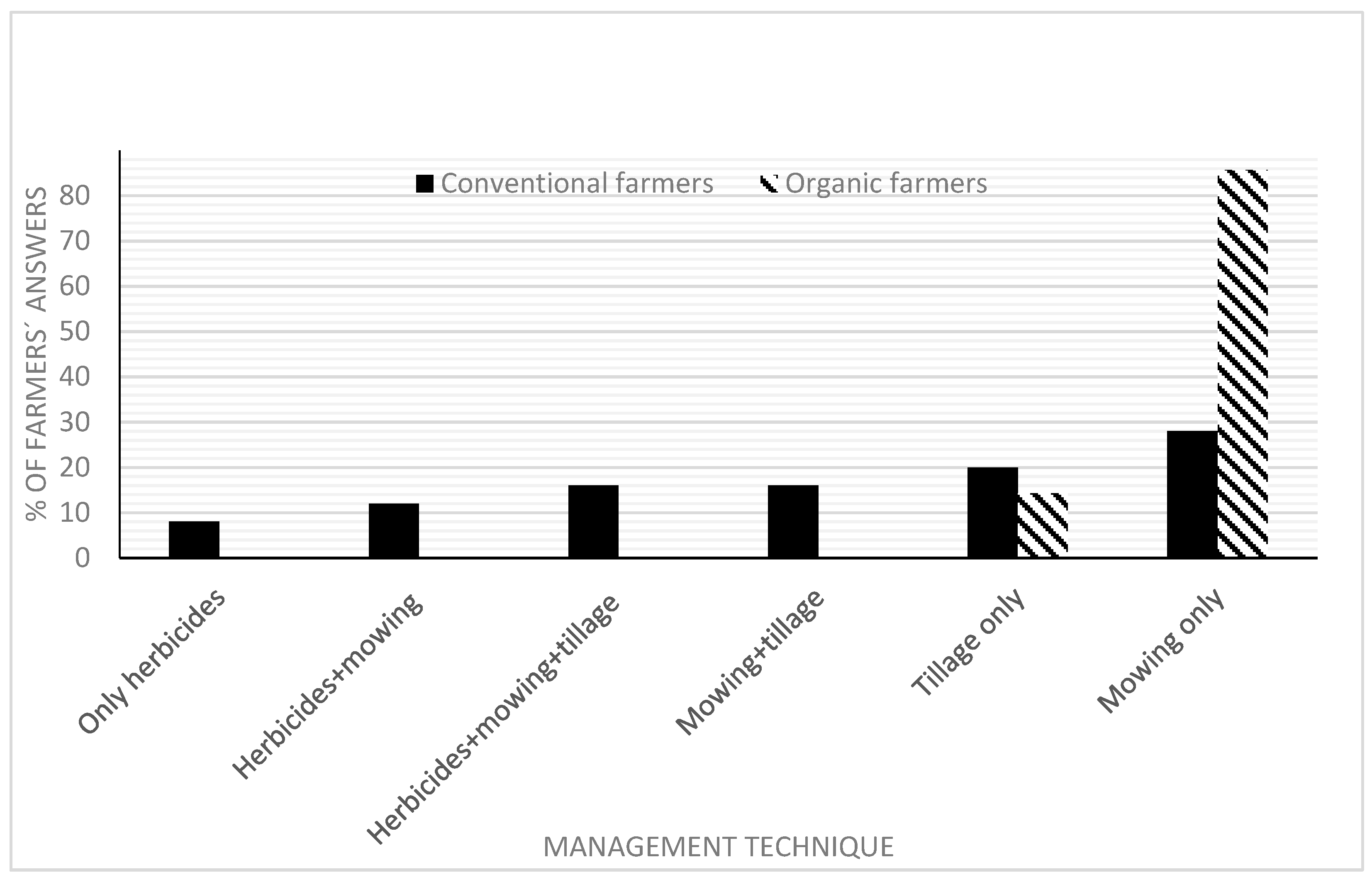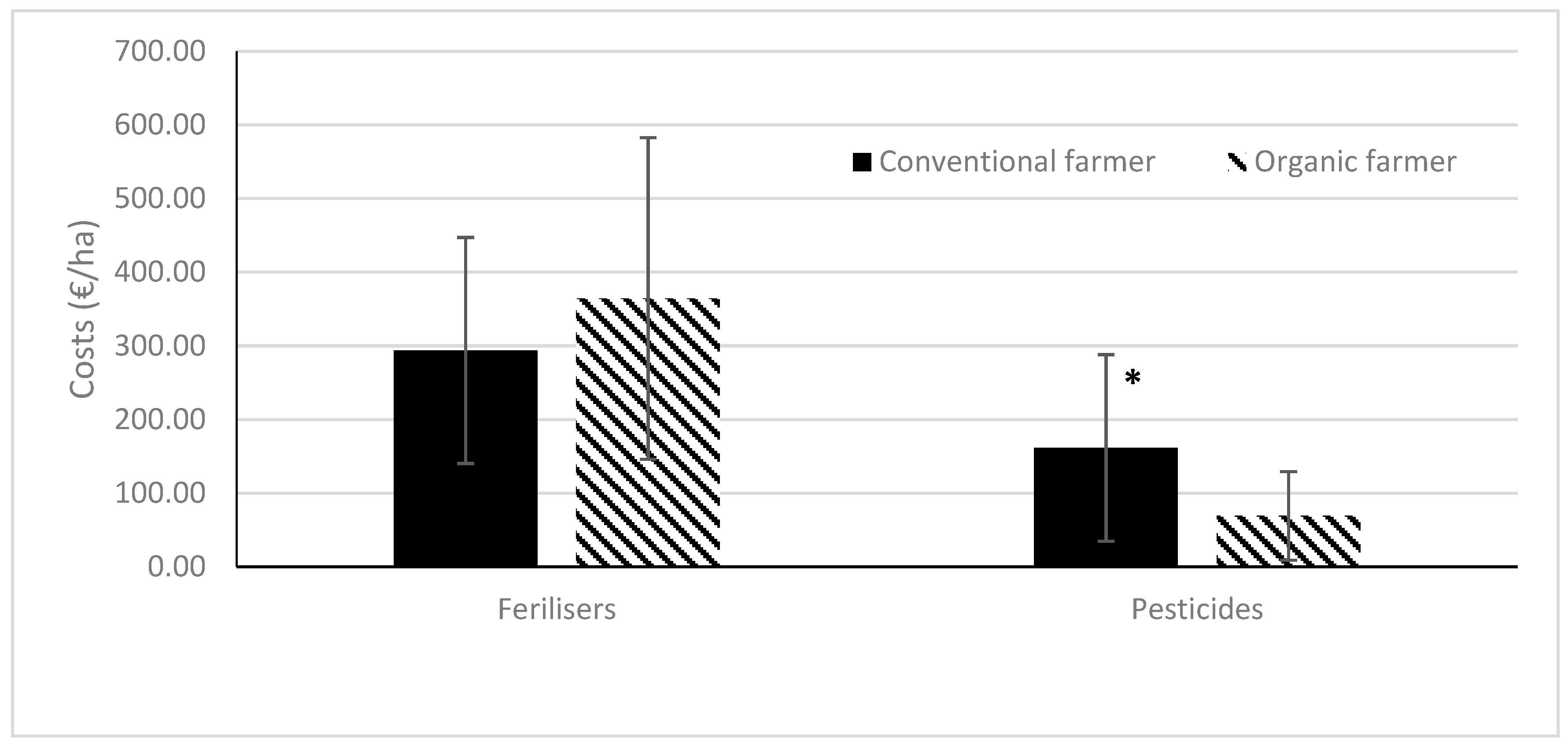1. Introduction
Olive farming is one of the most significant sources of income for agricultural areas in the Mediterranean basin, and the olive oil industry is an important part of the Greek agricultural sector [
1,
2,
3]. Traditionally cultivated olive groves provide important cultural and natural value, but more intensively farmed olive areas can also generate health and environmental impacts from pesticides, fertilizers and soil erosion [
1,
4,
5,
6]. These drawbacks can make farms less competitive on the market by impacting on their sustainability and product quality, and there is a need to improve the olive-growing sector’s management practices, by optimizing their resource use in a more effective and sustainable way [
5]. Innovations need to respond to new sustainability requirements, initiated through public policies (eco-conditionality) and at the private level by consumers and citizens that are increasingly concerned with the environment and human health [
1].
In this context, organic olive farming has previously been proposed as a strategic and sustainable option to conventional farming, with benefits for the environment, health and product quality. For example, a meta-analysis of 94 studies on the effect of organic farming on biodiversity has shown that biodiversity generally is 30% higher in organic farmland than in conventional [
7]. Organic farming means that no chemical pest control methods and no mineral fertilizers that are not naturally-derived are allowed [
8]. The organic farmers should also use practices that prevent soil erosion and maintain the soil organic matter (SOM) levels [
8]. There were 509 million hectares of organic agricultural land in the world in 2015, a number that has risen significantly since 1999, when there were only 11 million hectares [
9]. Still, the organic share of total agricultural land was not larger than 1.1% in 2015 [
9].
Europe has seen a steady increase of organic agricultural land [
9]. Austria and Sweden top the list of the European Union (EU) member countries with the highest share of the organic area in Europe [
10]. Greece is placed in the middle of the list, with approximately 6% of Europe’s organic agricultural area [
10]. In 2011, olive groves made up 31% of all the organic permanent crop area in Europe, and Greece was one of the three most important olive-growing countries in Europe [
10].
The area with olive groves in Greece has increased constantly during the last quarter century, as a result of the planting of new high-density farms [
4]. Farms of olive oil have expanded in many semi-mountainous and coastal areas (mainly in Crete and the Peloponnese region). The tendency is to intensify production through mechanization, levelling of the land, use of drip irrigation and increased use of external inputs, while the mixed cultivation of olive trees with other trees or arable crops is disappearing [
4].
The challenges of growing olive trees are, among other things, to provide them with water and nutrients and to control pests. The hot, dry summers in southern Greece cause high evapotranspiration, and irrigation is therefore sometimes required to obtain optimal yields, even though olive trees are considered drought resistant [
11]. The olive fly (
Dacus oleae) is the main pest affecting the olive plantations, causing problems both with lower olive yields and with lower quality of the oil [
4,
12,
13,
14]. Insecticides are commonly applied to olive groves to control pests, such as
Dacus oleae,
Saissetia oleae and
Prays oleae, and to increase the number and size of olives and the subsequent yields [
4,
13,
15]. Also, herbicides are commonly used against weeds, and there is a risk that these pesticides contaminate the quality of the olive oil [
4,
15]. The pesticides could also affect the farmers’ health and cause environmental impacts, such as contamination of water and soil and a decline in biodiversity [
4,
5,
6]. There might also be a problem with the pesticides killing the natural enemies of the pests, which makes the pest problem even bigger [
4].
Soil erosion is also considered as one of the main environmental impacts associated with intensive olive farming, causing the runoff of topsoil, fertilizers and pesticides into water sources [
4]. This is caused by the removal of all the natural ground vegetation by tillage or herbicide use, which is commonly used in conventional olive farming to reduce the competition for water and nutrients [
16,
17,
18]. However, the practice of totally removing the ground cover might have larger negative than positive effects on olive groves, because erosion reduces the soil’s productive capacity, which in turn leads to greater use of fertilizers [
4].
Organic olive cultivation more often involves maintaining a vegetative cover on the ground and less use of tillage and pesticides than conventional olive cultivation [
19], which, in addition to reducing soil erosion, has a positive effect on biodiversity [
17,
18]. About 7% of the Greek olive groves are organic [
10]. Since 2008, the organic olive area in Greece has decreased, a trend that differs from the other big olive growing countries—Spain, Italy and Portugal [
10]. At the same time, there is an increasing demand for organic olive oil, which can be sold for higher prices than the conventionally produced oil [
10]. There are studies indicating that organic olive farming can be equal or more profitable than conventional olive farming [
20,
21,
22]. The advantages of organic olive farming seem to be a combination of higher oil prices, higher subsidies and lower production costs [
20,
21,
22]. It has also been shown that reduced tillage, which is common in organic olive farming, can lead to higher yields [
23].
Thus, considering the declining trend of organic olive farming in Greece, despite an increasing demand for organic olive oil, it is urgent to investigate to what extent organic olive farming in Messenia could provide a financially competitive alternative to conventional olive farming. By comparing agriculture practices and the farmers’ attitudes to organic and conventional olive farming, the study also aims to compare the farming systems’ environmental sustainability and to assess the farmers’ perceptions of major benefits and difficulties with organic olive farming.
3. Results
On an average, organic farmers had larger farms than conventional farmers. They had a higher yield of olive oil per tree, but a slightly lower yield per hectare because of a lower number of trees per hectare (
Table 1).
Organic farmers had a somewhat shorter experience of olive farming than conventional farmers (
Table 2). Almost 90% of the organic farmers had more than 7 years of experience of working with organic olive certification (
Table 2); 30% of the conventional farmers did not want to start organic farming, while some 50% were uncertain and 20% wanted to start organic olive farming (
Table 2).
Both organic and conventional farmers believed that organic olive farming contributed to a better environment, health and quality of products (
Figure 2). A slightly larger proportion of the organic farmers also felt it was easier to sell organic olive oil and that this contributed to overall economic benefits (
Figure 2).
Conventional farmers perceived a low profit as the most critical difficulty with organic farming, which was not shared with the organic farmers (
Figure 3). They were also worried about difficulties in controlling pests and finding suitable fertilizers that would be allowed in organic olive farming. This was of less concern among the organic farmers. However, organic farmers were somewhat less satisfied with their pesticides and fertilizers (6.6 and 7.2 out of 10 scores, respectively) compared to the conventional farmers (7.8 and 8.4 out of 10 scores, respectively). Both groups of farmers felt that there was a lack of information and knowledge about organic farming, which was seen as a barrier to adopting the system (
Figure 3). The main concern among organic farmers was the high time demand, although there was no difference in the labor cost between organic and conventional olive farming (909 and 936 €/ha/year, respectively).
Labor cost made up approximately 60% of the total production cost for both groups of farmers, which is similar to what was found among 375 Greece olive farms assessed by the Farm Accountancy Data Network [
30].
Organic and conventional farmers used different fertilizers, except for the organically approved, nitrogen- and phosphorus-free fertilizer Patentkali, which was used by both groups. Most of the conventional farmers used traditional synthetic fertilizers, while most of the organic farmers used manure, compost and other organic methods (
Figure 4). In both groups, some farmers used more than one fertilizer.
Many of the farmers, and especially conventional farmers, used several pesticides to combat different kinds of pests (
Figure 5), while some 30% of the organic farmers used no pesticides at all. Conventional farmers were quite aware of the possible negative effects from pesticides and mentioned, for example, contamination of water and also that ‘good’ insects are killed by insecticides. One farmer mentioned that conventional agriculture has damaged the olive trees’ natural defense against pests, making them dependent on pesticides. The most commonly used insecticide by conventional farmers was Dimethoate. Organic farmers only used substances approved in organic farming. Spinosyn A and D (in Success) and Pyrethrins can be considered as naturally-derived chemical pesticides, whereas e.g.,
Bacillus thuringensis is a biological defense and kaolin (in Surround) only works as a physical protection. Copper compounds were commonly used by both organic and conventional farmers as fungicides. No herbicides against weeds were used by the organic farmers.
Dacus oleae, also called the olive fly, was considered to be one of the most problematic pests by 40% of the farmers. Different kinds of fungi and the insects Calocoris trivialis (local name Kalokori) and Prays oleae (local name Pyrinotritis) were also considered as problematic.
All farmers used some kind of ground vegetation removal during part of the year. The reasons were mostly to facilitate the harvest, during which the olives are gathered and picked from the ground, and to keep away pests that breed in the humid environment created by the vegetation. Only conventional farmers used herbicides (Glyphosate) (
Figure 6); 86% of the organic farmers used mowing as the only technique, which leaves a cover of short grass on the ground, while some 70% of the conventional farmers used either tillage or herbicides, which often leaves the soil bare (
Figure 6).
Agrochemicals constituted some 30% of the total cost accounted for in this study, where organic farmers had a significantly lower cost for pesticides but a slightly higher cost for fertilizers as compared to conventional farmers (
Figure 7). The two groups of farmers had similar production costs (
Figure 7), but organic olive farmers earned a significantly higher gross income from olive farming as compared to conventional farmers (
Figure 8). The main reason for this was that they secured a significantly higher price for their olive oil as compared to the conventional farmers (
Figure 8,
Table 1). As a result the net income was significantly higher for organic farmers as compared to conventional farmers (
Figure 8).
Organic farmers also received somewhat higher subsidies as compared to conventional farmers, which further increased their profit (
Table 1,
Figure 8). A significantly larger proportion of the organic farmers’ income came from olive farming (86%) as compared to conventional farmers (66%) (
Table 1).
4. Discussion
Olive farming is deeply integrated in the nutritional, historical, and cultural identity of Greece. Olive farming and the olive oil industries also have a significant impact on the country’s rural economy and the environment. Although some olive oil producers have embraced sustainable agriculture techniques to ensure the long-term health of both the industry and the environment, the overall trend is towards more intensive methods [
4]. Still, organic farming and other integrated farming strategies could provide sustainable alternatives to more intensive farming strategies, recognizing that olive groves provide more benefits than just olives [
4,
6].
Our results (
Figure 4,
Figure 5,
Figure 6,
Figure 7 and
Figure 8) showed that organic farming is both more environmentally and financially sustainable than conventional farming, which is in accordance with Romero-Gamez et al. [
6], who found that organic farming showed the lowest impacts and that integrated production was the best olive production system from an overall environmental and productive point of view.
In our study organic farmers used less synthetic pesticides than conventional farmers, who mainly relied on pesticides, such as Glyphosate and Dimethoate, that have been linked to toxic effects on the environment and human health and also can contaminate the olive oil [
31,
32,
33]. Likudis et al. [
13] found that 56% of 70 olive oil samples from Greece contained pesticides, with an average of 2.25 pesticides per sample in the oil from the Peloponnese region. Amvrazi and Albanis [
15] found Dimethoate in 80% of the samples of extra virgin oil from conventional olive farms in Peloponnese. They also found that 60% of the samples of organic olive oil contained pesticides and concluded that these pesticides could come from conventional farms. Even if all of the pesticide concentrations were far below the acceptable daily intake (ADI), and posed no risk for human consumption [
15], high-quality olive oil should preferably not contain any pesticide at all. Many conventional farmers said that they would feel better providing consumers with organic products, and both groups of farmers agreed that organic farming contributed to a better health for both themselves and the consumers. Still, the fairly common use of copper compounds is also of some environmental concern among organic farmers [
34].
The lower reliance on synthetic fertilizers among organic farmers also makes these operations more sustainable than conventional farming, although one could expect a leakage of nutrients from both systems. Romero-Gamez et al. [
6] compared traditional systems with intensive and super-intensive olive farming systems in Spain, and found that fertilizers had the highest impact on the environment for all systems. The leakage of nutrients could be especially critical in coastal areas, where a good water quality is important for coastal-related activities, such as fisheries and tourism, which are important activities in Messenia. Thus, improved fertilization should be the first priority for optimizing olive growing, particularly in the organic systems, since manure fertilization, which was commonly used among the organic farmers in our study, can easily result in high costs and high environmental impacts if mismanaged [
34].
Organic farmers also applied more environmentally-friendly ground vegetation management techniques (mowing), as compared to conventional farmers, who to a larger extent relied on tillage and herbicides [
19,
34]. Milgroom et al. [
19] found that farms managed with tillage had the least vegetation cover, the highest erosion risks and the lowest SOM values. Soil managed by grazing livestock or mowing had the highest SOM values [
19]. These aspects were also connected to the water infiltration rates [
19], where increased infiltration decreases the runoff and thereby decreasing the erosion rates [
35]. Pimentel et al. [
35] made a comparison between organic and conventional corn and soybean fields, which showed that the runoff is lower in the organic fields, generating more groundwater recharge. More water was also retained in the organic soil because of a higher SOM content, which made a significant difference on the crop yields under drought conditions [
35].
Our study also showed that organic olive farming provides a financially competitive alternative to conventional olive farming (
Figure 8). This is a significant result because the common belief among the conventional farmers interviewed was that organic olive farming provided a lower profit than conventional farming, and this was seen as the major argument against organic olive farming. However, the results show that organic olive farmers neither obtain significantly lower yields nor have higher production costs than conventional olive farmers, and that the profitability is significantly higher for the organic farmers. These results are in line with Sgroi et al.’s [
20] cost-benefit analysis of organic and conventional olive farming in Sicily, Italy, where they concluded that organic olive farming was more profitable both with and without the extra subsidies that organic farmers received. In the study by Sgroi et al. [
20], though, organic olive farming had a lower oil yield (659 kg/ha) than conventional farming (899 kg/ha), which was not seen in our study, where the oil yield was similar between the two farming categories.
Paydar et al. [
21] compared the economic performance of organic and conventional olive farming in Rudbar, Iran. Unlike the results of the present study, they found no significant difference in the profitability between organic and conventional farms [
21]. The production costs were significantly lower for the organic farmers, but so was the production value. In the local market of Rudbar there was, however, no price difference between organic and conventional olives, which was the case in our study.
The price difference for olive oil from organic and conventional olive farming is a major factor contributing to the higher profitability in organic olive farming [
20,
34]. This indicates the importance and potential that organic farming strategies have to protect and even further develop the high quality of the olive oil produced in the region. Being recognized as a Protected Designation of Origin (PDO) is a competitive advantage against other olive producers and creates a demand and market for high-quality olive oil from the region that is considered as extra fine, which should be managed with care. According to Klonaris and Agiangkatzoglou [
2], there is a small, but growing percentage of consumers who are willing to pay quite dearly for top quality olive oil, and this a may be an important way for Greek olive farmers to compete in the olive oil market. It is well known that Greece enjoys a higher share of high-quality extra virgin olive oil (almost 80% of its total production), which is considered as a premium product in the international market [
2]. One of the objectives of PDO is to improve the income of farmers, in return for a “genuine effort to improve quality”. This objective fits well with the strategies for organic olive farming in Messenia, where a more selective use or agrochemicals safeguard a high quality olive oil, which in return generates a higher price and profit for organic olive oil.
Organic farmers were more aware of the higher demand for organic olive oil than conventional farmers. This awareness of the higher price and demand for organic olive oil is critical for creating a ‘mind-set’ where sustainable production strategies are seen as an important way to increase profitability, and it was quite surprising that conventional farmers seemed to be more aware of the health and environmental benefits than the financial benefits with organic olive farming. Still, with a trend of increased tourism in the study area, it is likely that this demand for organic-certified olive products will increase even further in the future and could provide an important mechanism to further stimulate organic olive production, especially if conventional farmers increasingly would recognize that organic farming could be a way to increase rather than decrease profitability. Sustainable innovation would in this sense increase production efficiency and economic performance [
1]. This in turn would indirectly contribute to environmental and health benefits for the region, which in the long run may be even more important than the short-term financial gains.
Iofrida et al. [
1] recently found that many actors involved in olive farming in Italy perceived a need to orient Calabrian olive growing towards more sustainable management practices, by better exploiting its potential and focusing on product quality. This may be even more important in Messenia, where the morphology of the landscape is an obstacle for ‘mechanized’ harvesting, which is commonly applied in Spain and Italy. The production of high-quality olive oil may be one of the few ways for Messenia to compete with other olive oil-producing countries, which may be better suited for the production of high quantities.
Thus, there is a promising potential for enhanced organic olive farming in Messenia, which would provide a sustainable alternative to conventional olive farming. Our study showed that most farmers already perceive major environmental and health benefits from organic farming. They also feel that it enhances the quality of the olive oil. Twenty percent of the conventional farmers were interested in starting organic farming and another 50% were uncertain. Thus, more information, similar to this study, that shows that organic olive farming also is at least as profitable as conventional olive farming, could be critical to convince more farmers to start with organic olive farming. However, there is also a need to provide technical know-how and information to farmers about, for example, alternative pesticides and fertilizers, so they can more easily start with organic farming. New innovative agricultural systems should not only consist of new technical or organizational solutions; a core issue in sustainable innovation is also about how knowledge is produced and shared [
5]. Processes should be innovated by connecting scientific research, stakeholders, local actors and policy makers and fostering participation and collaboration between these different types of actors [
36].
The time demand was also mentioned as a difficulty with organic farming by several organic farmers, although this was not mentioned by the conventional farmers. Still, this might imply that the conversion to organic farming is mostly applicable to full-time, or nearly full-time, farmers. However, it could also be argued that more farmers would be able to work full-time with their olive cultivation if they get a higher profit by applying organic farming strategies. Some organic farmers also said that they enjoyed allocating extra time and effort to their farms. They felt good about taking care of the farms, and it made them feel a stronger connection to their farms and prouder about their products. This ‘mind-set’, coupled with convincing proof that organic olive oil production not only provides environmental and health benefits, but also provides higher quality products, which are in higher demand and more profitable than conventional olive farming, is needed to further expand organic olive farming in Messenia. This would probably not only make financial sense to the individual farmers, but also contribute to a diversification of production systems and enhance the environmental quality of the whole region over time.


